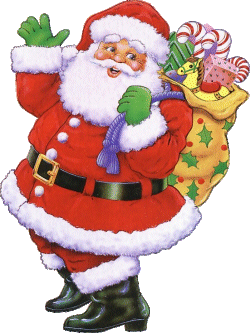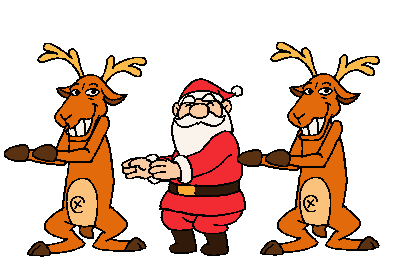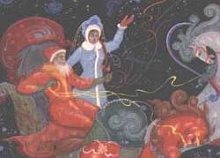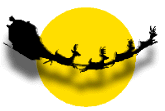


The American version of St. Nicholas, or Santa Claus originally came from the Dutch version called Sint Nikolaas or Sinterklaas. The Dutch settlers in New Amsterdam (New York) brought this fun and lively tradition (some even say cult) to America.
 This
version of Santa has given the current myth its visual form and these most curious
traditions:
This
version of Santa has given the current myth its visual form and these most curious
traditions:
A merry old man with red and white clothes
Eight flying reindeer, later joined by Rudolph the red nosed reindeer.
A home located on or near the North Pole
The habit of filling socks or stockings with presents on the night of December 24th.
Also the habit of entering houses through the chimney.
The most important single source for our modern day version of Santa Claus comes from the Christmas poem A Visit From St. Nicholas by Clement C. Moore. Written for his children in 1823, the family poem was later published for the general public and included what became the now famous picture of Santa Claus by Thomas Nast ( see below right ).
Actually the old "cult" of Santa Claus incorporates many traditions: Christian and Pagan, Old Catholic, Scandinavian, Dutch, German and English.
Santa brings us all together! Kids all over the world know who Santa is... And although he may be a little commercial, who can help, but love the jolly old elf?
It's the Idea of giving that reminds us; we are all on this planet together, for the long run.
So lets be kind to one
another.


Countless legends (no documents exist) are told about this Patron Saint of Giving known as St. Nicholas. Within both Western and Easter Christian Churches similar mythology, or tradition, exists.
According to these legends, St. Nicholas was born in the city of Patara, and traveled to Palestine and Egypt when he was young.
He was later imprisoned during persecutions of the Emperor Diocletian, but was fortunately released by the more humanitarian Emperor Constantine. He attended the first council of Nicaea in 325.
In Greek, St. Nicholas is known as Hagios Nikolaos, Bishop of Myra (in the present day Turkey),
St Nicholas reportedly died about 350 AD.
Today, this mythical character is still alive and well and is known all over the world as: Nicholas of Myra, Santa Claus or "Santa" in America.
His fame spread rapidly during the Middle Ages and thousands of churches are dedicated to him.
He has been the patron saint of Russia, Moscow, Greece, children, sailors, prisoners, bakers, pawnbrokers, shopkeepers and wolves.
His gift-giving role in Christmas rites probably follows from his fame as the friend of children. The story also tells that he used to give anonymous donations of gold coins to persons in need. His cult spread in Europe and Christmas presents were distributed on December 6th when the celebration of St. Nicholas took place.
In many countries this day is still the day of Christmas gift-giving, although there is a mounting pressure everywhere to conform to the custom of 24th/25th December. The relics of St.Nicholas are in the basilica of St. Nicola, in Bari, Italy (they were stolen from Myra in 1087 AD). For this reason he is sometimes known as St.Nicholas of Bari.
In Germany 'Weihnactsmann' (Christmas man) dresses up as 'Nikolaus' and brings sweets, fruits, nuts and smaller presents to children on December 6th.

 The Russian Grandfather Frost has strong Pagan relations. He is always accompanied by his granddaughter
Snegurochka (Snow girl), a merry girl who helps Grandfather Frost provide a New Year party for children
as well as bringing them gifts. He wears a long fur coat covered by bright beautiful cloth (blue or red) trimmed in fur. According to new tradition, Grandfather Frost and Snegurochka live in the town Veliky Ustug
from which they begin their New Year journey by troika of white horses.
The Russian Grandfather Frost has strong Pagan relations. He is always accompanied by his granddaughter
Snegurochka (Snow girl), a merry girl who helps Grandfather Frost provide a New Year party for children
as well as bringing them gifts. He wears a long fur coat covered by bright beautiful cloth (blue or red) trimmed in fur. According to new tradition, Grandfather Frost and Snegurochka live in the town Veliky Ustug
from which they begin their New Year journey by troika of white horses.
Today Grandfather Frost is connected to New Year celebrations, but before 1917 he was much more related to Christmas. Grandfather Frost and Snegurochka visit children asking them to sing or read a poem, sometimes asking if they were good, and of course giving presents.


Generally Father Christmas is known as a bearded old man in a fur costume who appears in Yuletide and gives presents.
His characteristics can be divided roughly into two groups: Those with traditional religious significance, and those with pagan origin
Origins of Santa's many funny traditions and customs:

This name comes from the country Finland. Literally meaning: Yule Buck. This Old pagan tradition remained strong in Finland but got a Christian flavor as time went by.
Pagan people used to have festivities to ward off evil spirits. In Finland these spirits of darkness wore goat skins and horns. In the beginning this creature didn't give presents but demanded them. The Christmas Goat was an ugly creature and frightened children.
It is unclear how this personality was transformed into the benevolent Father Christmas. Nowadays the only remaining feature is the name. The process was probably a continuous amalgamation of many old folk customs and beliefs from varied sources. One can speak of a Christmas pageant tradition consisting of many personages with roles partly Christian, partly pagan: A white-bearded saint, the Devil, demons, house gnomes, whatnot.Nowadays the Joulupukki of Finland resembles the American Santa Claus.
Popular radio programs from the year 1927 onwards probably had great influence in reformatting the concept with the Santa-like costume, reindeer and Korvatunturi (Mount Ear, near Polar Circle) as its dwelling place. Because there really are reindeer in Finland, and we are living up North, the popular American cult took root in Finland very fast. Maybe some caring soul decided the Joulupukki is just too scary for little kids.
Today, Finland is one of the few countries where kids actually see Father Christmas in the act of delivering the presents and probably the only country where the Saint really does ask the children if they behaved during the year.

 In the United States and Canada, his name
is Santa Claus.
In the United States and Canada, his name
is Santa Claus.
In China, he is called Shengdan Laoren.
In England, his name is Father Christmas, where he has a longer coat and a longer beard.
In France, he's known as Pere Noel.
In Germany, children get presents from Christkind (Christkindl in Austria and South Germany), the Christ Child.

Customs of the Christmas Season in Spanish speaking countries have many similarities, and many variations. All of Latin America and Spain are predominantly Catholic. For many of these countries Baby Jesus, el Niño Jesus, brings gifts for children.
In Costa Rica, Colombia, and parts of Mexico, the gift bearer is el Niño Jesus, “the infant Jesus.” In Brazil and Peru, he's called Papai Noel.
In Puerto Rico, children receive gifts from the Three Kings on January 6th, also called the celebration of Epiphany, the 3 Kings' Day. Each child puts grass under their bed for the camels. In the morning the grass is replaced with gifts. Also, Puerto Rico, being part of the United States, does its major gift giving on December 25, with the Christmas Tree and Santa Claus - in this sense, Puerto Rico is totally Americanized.
Epiphany remains a part of the holiday season in Puerto Rico and is a day off from school. Giving gifts then is more for traditional values than the actual gift-giving celebration. Unless one wants to make a specific statement about the importance of maintaining traditional purity (anti-commercialism) and disassociation from American influence.
However, the celebration of Epiphany is not just in Puerto Rico. Some nations say it is the 3 Kings who bring the toys, while others credit Baby Jesus, since it was He who received and wants to share.
In Italy Babbo Natale, which means Father Christmas, is Santa. Children put a pair of their shoes by the door on the day before Epiphany and the following morning they find them filled with small gifts and candy. Italy, like Spain, Portugal and most of the Latin American nations ( or countries speaking Romance languages), is mostly Catholic. December 25 is a day of more religious observance, remembering the birth of Christ. The Epiphany, called Little Christmas, is the day for gift giving. However, Babbo Natale does come on Christmas Eve in some parts of Italy.
In Spain children leave their shoes under the Christmas tree the night of January 5th and presents from the Three Kings (Los Reyes Magos: Melchor, Gaspar and Baltasar) appear the next morning. Santa Claus is called Papa Noel and some children receive presents both days on December 24th (from Papa Noel) and on January 6th (from the Three Kings).
In Morocco he is known as Black Peter
In Japan, Santa Claus is called Santa Claus or just “Santa”. Children often call him “Santa no ojisan”, which means “Uncle Santa”. (This information comes to you via the courtesy of Mr. Kazuo Miyasako of Dokkyo University. Many thanks go to the readers of Lone Star Internet)
In Sweden Jultomten visits the evening before Christmas day, pulling a big bag of julklappar (Christmas presents) in the deep snow.
Pã Norsk ( in Norwegian ) “Julenissen” arrives on the evening of the 24th.
In the Netherlands, he is called Kerstman.
In Finland, he is called Joulupukki.
Sinter Klaas in Dutch. He is much thinner than the American Santa Claus. He rides a white horse and gets help from numerous Zwarte Pieten (Black Petes) handing out gifts and candy. He arrives the first Saturday in November by Boat. In the evenings, Dutch Children sing songs in front of the fire place or in the living room and leave their shoe with a present (drawing for Sinterklaas and Zwarte Piet or a Carrot for Amerigo Sinterklaas' horse) In the mornings they will find their shoe filled with candy and small presents. On the 5th of December Dutch households have a “Pakjesavond” (Presents night) and exchange presents.
In Russia, he is called Grandfather Frost that is “ded moroz” (the second “o” has its accent and the last “z” is pronouned as “s”.)
He is also called Kris Kringle -
which comes from the German term “the Christ
Child”


Many writers have been instrumental in designing the features of Christmas.
One of the most influential was Clement Moore whose poem, The Night Before Christmas “ A Visit from St. Nicholas”, which depicted an early nineteenth century American Santa Claus, one which endures for all generations.
Thomas Nast, the painter, got his inspiration from Moore's world famous poem.
Thereafter no one could prevent the inevitable triumph of Moore's Santa.

 Thomas Nast, a well
known and respected painter, found inspiration for his extremely popular painting of today's
Santa Claus from Clement C. Moore's world famous poem,
The Night Before Christmas (“A Visit from St.Nicholas”).
Thomas Nast, a well
known and respected painter, found inspiration for his extremely popular painting of today's
Santa Claus from Clement C. Moore's world famous poem,
The Night Before Christmas (“A Visit from St.Nicholas”).
Thereafter no one could prevent the inevitable triumph of Moore's lovable Santa.
Thus Thomas Nast, a very real and now historical newspaper artist, was the VERY FIRST PERSON to paint the first definitive portrait of our present day Santa Claus in 1870.
